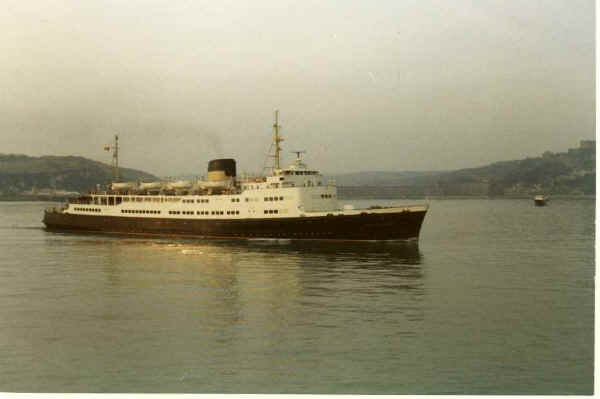|
|
|
The picture above, taken some time in the late 1960s, shows
the Belgian Marine passenger ferry Konigen Elisabeth just having left its berth
at the Admiralty Pier for Oostende in the early evening. Built by
Cockerill's of Hoboken in 1956 for the Belgian Marine Administration's
Ostend-Dover service, she was launched on October 29th 1956 and delivered on
15th March 1957, being placed in service in May the following year. At
3,389 tons gross, with a capacity of 850 passengers, 160 cars and 7 coaches
or caravans, she remained in service on the run until 15th October 1977.
On 14th April 1978 she was sold to Abna Marine in Cyprus and renamed Abna. |
|
|
|
.
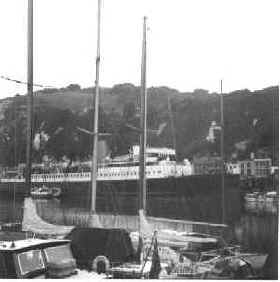
BRS Canterbury awaiting scrap
Not very clear, I'm afraid, but this black and white snap was taken from
the seaward side of the Wellington Dock looking towards Snargate Street and the Western
Heights (some of the buildings on the heights can just be distinguished on the skyline).
The picture shows the British Rail (Southern Region) ship Canterbury
shortly before she sailed for the scrap yard in tow of a Belgian tug on 30th
July 1965.
Launched in 1928, Canterbury was specially built for the Golden
Arrow luxury service between London and Paris, originally being all
first-class. She made her maiden voyage on the run on 15th May 1929.
From 15th May 1932 economic conditions forced her to carry second-class
passengers as well.
She was converted into a troop transport in 1939 and took place in the
Dunkirk evacuation, rescuing several thousand troops. Following a
rather chequered war-time career, she was handed back to the Southern
Railway in 1946, where she resumed the Golden Arrow run on April
15th. She was replaced by Invicta in October 1946 and
transferred to the Folkestone-Boulogne route, where she remained in service
until 27th September 1964.
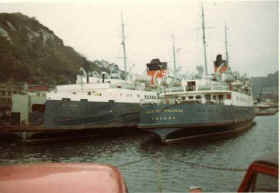
MV Lord Warden and Maid of Orleans
In the winter season, ferries were often laid up in the Wellington Dock. This
picture shows the car ferry, MV Lord Warden and a passenger ferry, Maid of
Orleans alongside what was once called Commercial Quay.
Lord Warden was the third ship of that name to travel the short
sea routes from Dover. Launched in December 1951 she was designed for
the Dover-Boulogne run, with a capacity of 1000 passengers and 120 cars.
Her passenger capacity was reduced to 600 in May 1978 when she was
transferred to the Irish Sea.
Maid of Orleons was launched in 1948 as a replacement for the
Biarritz. She could carry 1,400 passengers and, in the winter,
25-30 cars, crane-loaded into the hold.
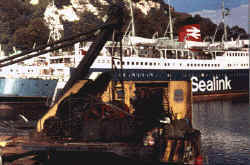
These unidentified vessels are partly hidden by a crane barge

Sealink ferry showing SNCF logo on funnel
The picture above shows a French Sealink ferry turning in the harbour to approach the
dock stern first. The Southern Breakwater is lined with fishermen.
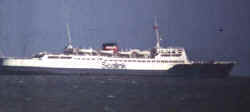
Sealink ferry showing SNCF logo on funnel
|
|

Cargo vessel at the Custom House Quay
I couldn't resist taking this picture of a coaster alongside the Custom House Quay -
the water in the Granville Basin was so smooth it acted like a mirror. In the
background, you can just pick out the entrance to the Caves in the base of the cliff and
the Citadel Barracks at the top left of the picture.
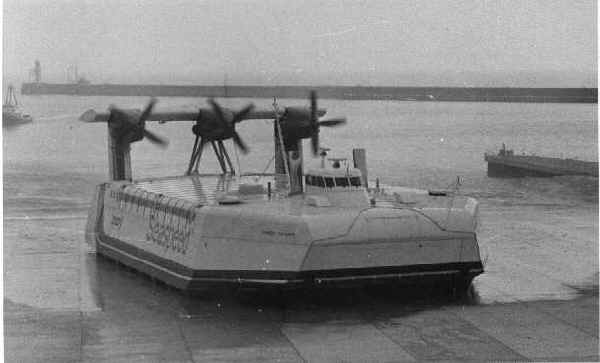
Ingenieur Jean Bertin
This strange looking craft is the SNCF hovercraft Ingenieur Jean Bertin, seen
arriving at the new hoverport at the western end of the harbour late in 1978. I was
working on the plant room at the time and climbed up on the roof to watch it come in - the
first craft to land on the new pad.
With its three propellers in line abreast on the stern, it was not very
manoeuvrable,
and took several minutes to navigate round the end of the Prince of Wales Pier and come to
rest on the centre of the pad.
It was a very different site when the first British craft arrived back from the Isle of
Wight a few days later.
The Bertin (we christened it the "flying biscuit tin") was taken out
of service after a couple of seasons. A sister craft mysteriously caught fire on the
stocks before it was completed.
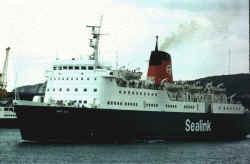
Sealink ferry "St Eloi" showing ALA logo on funnel
Launched in 1972, Saint Eloi was designed as a multi-purpose vessel,
carrying passengers as well as roll-o, roll-off cars, lorries and railway
vehicles.
Built for the Société Anonyme de Navigation Angleterre-Lorraine-Alsace (ALA)
she arrived in Dover for the Dunkirk route in February 1975 after extensive
delays in the Italian shipyard. She became British owned in January
1978, although remaining French crewed. During the summer months she
ran on the Dover-Boulogne passage, carrying up to 1000 passengers and 160
cars, or 35 rail freight wagons, or 10 sleeping coaches and 11 freight
wagons.
The picture shows her leaving the train ferry dock.
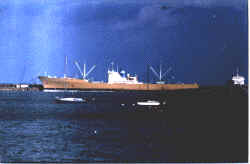
Freight being unloaded at the Eastern Arm
|
